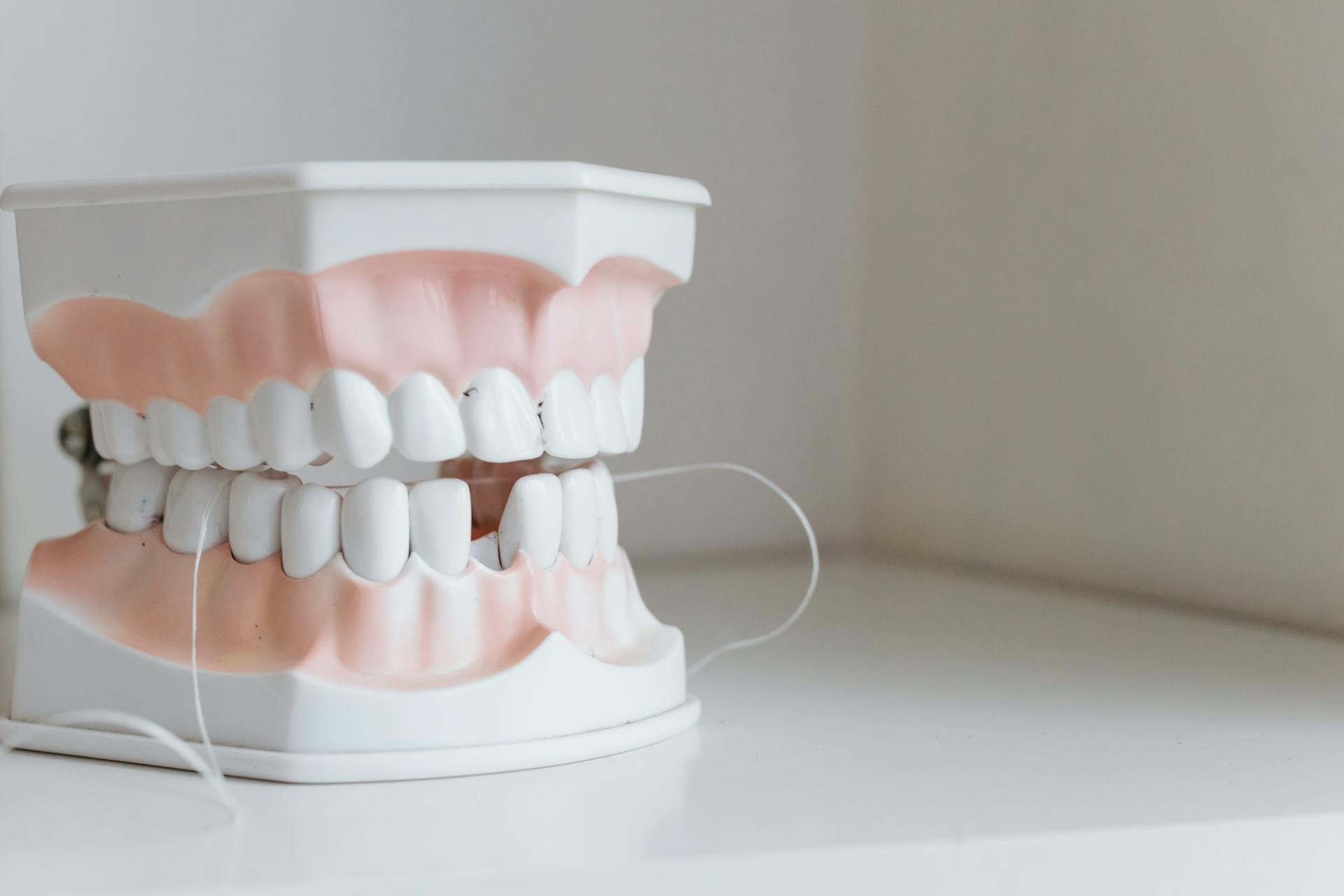
A partial denture is a removable dental prosthesis used when one or more natural teeth remain in the jaw. They are made to closely resemble your natural teeth and are attached to a pink or gum-colored base. Depending on the number of teeth remaining, your dentist will design a partial denture for you.
A well-fitting partial denture should be comfortable and stable, yet easy to remove for cleaning. It should not loosen with chewing or talking and should fit snugly against your gum tissue. To ensure a comfortable fit, your dentist will take measurements and make a model of your mouth before creating your denture.
It is important to keep your partial denture clean and free of food debris and plaque. Brush your denture daily with a soft-bristled toothbrush and mild soap. Be sure to clean under the denture where it meets your gum tissue. You should also remove your denture nightly to give your gums a chance to rest.
If you experience any discomfort with your denture, such as sore spots on your gums, contact your dentist. He or she can make adjustments to the denture or reline it to improve the fit. With proper care, your partial denture can last for many years.
Discover more: Partial Dentures
How loose should a partial denture be?
A partial denture is a removable dental appliance that is used when one or more natural teeth remain in the upper or lower jaw. The appliance fills in the spaces created by the missing teeth and prevents other teeth from shifting position. A partial denture consists of replacement teeth attached to a pink or gum-colored plastic base, which is connected by metal framework that holds the denture in place in the mouth.
The denture should be loose enough to allow natural movement of the teeth and jaw, but snug enough to stay in place when you bite or chew. If the denture is too loose, it will rub against the gums and cause irritation. If the denture is too tight, it will put pressure on the gums and cause discomfort.
The best way to determine if your denture is the right fit is to consult with your dentist or dental prosthetist. They will be able to make any necessary adjustments to ensure a comfortable and secure fit.
Readers also liked: Double Insulated Appliance
What are the consequences of a partial denture that is too tight?
A partial denture that is too tight can have a number of consequences. First, it can be uncomfortable to wear, as it puts pressure on the gums and teeth. This can lead to soreness and inflammation of the gums. Second, a tight denture can make it difficult to eat and talk. This is because the denture is pressing on the gums and teeth, making it difficult to move the jaws. Third, a tight denture can cause the teeth to shift. This is because the denture is putting pressure on the teeth, which can cause them to move out of alignment. Fourth, a tight denture can lead to gingivitis. This is because the denture is trapping bacteria against the gums, which can cause infection and inflammation. Fifth, a tight denture can cause tooth decay. This is because the denture is trapping food and plaque against the teeth, which can lead to decay. Sixth, a tight denture can cause gum disease. This is because the denture is trapping bacteria against the gums, which can cause inflammation and infection. Finally, a tight denture can make it difficult to clean the teeth. This is because the denture is making it difficult to reach all of the teeth, which can lead to plaque build-up and infection.
Broaden your view: Trapping Benefits
What are the consequences of a partial denture that is too loose?
A partial denture that is too loose can have a number of consequences. First and foremost, it can be extremely uncomfortable to wear. If a partial denture is not fitting properly, it can rub against the gums and cheeks, causing irritation, redness, and even bleeding. Additionally, a loose partial denture can cause difficulty eating and speaking. When a partial denture moves around in the mouth, it can make it difficult to bite and chew food properly, and can also lead to slurred speech. Additionally, a loose partial denture can put a person at risk for aspirating (breathing in) the denture, which can lead to pneumonia. Finally, a loose partial denture can also cause the teeth to shift, which can lead to further dental problems down the road.
A different take: What Are the Best Places to Elope in California?
How can you tell if a partial denture is too tight?
If your partial denture feels too tight, there are a few signs to look for. First, you may notice that your denture does not fit as snugly as it used to. Additionally, you may see that your gum tissue is red and irritated. Finally, you may experience pain when wearing your denture. If you notice any of these signs, it is important to consult with your dentist. They will be able to adjust your denture so that it fits more comfortably.
Curious to learn more? Check out: What Is Friction?
How can you tell if a partial denture is too loose?
A partial denture is a removable dental appliance that replaces one or more missing teeth. Partial dentures are usually made of acrylic and metal. They are held in place by natural suction or by a clasp that attaches to adjacent teeth (called abutment teeth).
If a partial denture is too loose, it will not stay in place. It can rock back and forth or even fall out when you are eating or talking. A loose partial denture can also cause irritation to your gums.
If you think your partial denture is too loose, please see your dentist as soon as possible. He or she will check the fit of your denture and make any necessary adjustments.
Intriguing read: Partial Braces
What can you do to adjust a partial denture that is too tight?
A partial denture that is too tight can be adjusted in a number of ways. First, you can try to stretch the partial denture out by gently pulling on it with your hands. You can also try to push the partial denture down or up with your tongue. Finally, you can try to bite on the partial denture to loosen it.
Related reading: Does the Devil Try to Break up Relationships?
What can you do to adjust a partial denture that is too loose?
A partial denture is a removable dental appliance that is used to replace one or more missing teeth. This appliance is held in place by natural suction or by clasps that attach to adjacent teeth. A partial denture that is too loose can be very uncomfortable and can make it difficult to eat and speak. If you have a partial denture that is too loose, there are a few things that you can do to adjust it.
The first thing you can do is to try to adjust the partial denture yourself. This can be done by gently bending the metal framework of the appliance. Be careful not to bend the framework too much, as this could cause the partial denture to break. If you are able to adjust the partial denture yourself, make sure to have it checked by a dental professional to ensure that it is still fitting properly.
If you are not able to adjust the partial denture yourself, or if the denture is still not fitting properly after you have made adjustments, you will need to see a dental professional. A dental professional can make adjustments to the denture and can also make any necessary repairs.
If you have a partial denture that is too loose, there are a few things that you can do to adjust it. Try to adjust the partial denture yourself first, but if you are not able to, or if the denture is still not fitting properly, you will need to see a dental professional.
Readers also liked: What Had Montag Been Able to Memorize?
Is it better to have a partial denture that is too tight or too loose?
It is better to have a partial denture that is too tight than too loose. If a partial denture is too loose, it will not stay in place and will not be able to function properly. In addition, a loose partial denture can cause gum irritation and pain.
Broaden your view: Can You Use Bleach on Your Areola?
Frequently Asked Questions
How are partial dentures fitted?
Partial dentures are fitted by a dentist, who will use an X-ray to map out where your teeth were missing. The denture will then be made to fit around the remaining teeth. Partial dentures can either be fitted with clasps or precision attachments which screw into the remaining teeth.
Are your dentures fitting well?
The first thing you'll want to do is to make sure your dentures are fitting properly. You may have to adjust them a few times during the day, depending on how you're chewing and so on. If they are constantly falling out, or if they cause a lot of pain when you eat or drink, it's likely that they aren't fitting well. If the dentures are causing discomfort in any way, there are a couple of things you can do to fix the issue. First, try adjusting the fit by trial and error. You may also need to see a dental professional for assistance. If neither of these solutions work, you may be considering replacing your dentures with false teeth altogether. How do I make my dentures fit better? There are a few things you can do to improve the fit of your dentures: Adjust their position – To adjust the position of your dentures, simply loosen the buckles and slide them until
Do I need to have my denture adjusted?
Yes, it is important to have your denture adjusted every 6 to 12 months depending on how you are using the denture. A properly fitted denture should fit snugly with no room for air bubbles. If there is air in the denture, it can cause pressure and discomfort. Additionally, if your denture has shifted or slips while you are sleeping, eating or drinking, it may need to be adjusted.
How long should I Wear my partial denture?
Your dentist may instruct you to wear your partial denture for a certain length of time, typically around six to eight weeks. After this time, it may be necessary to have the denture adjusted if it's causing discomfort or not fitting properly.
What is a partial denture?
Partial dentures are a type of artificial tooth. They are designed to fill in the gaps left by one or more missing teeth. Partial dentures can be made from plastic, nylon or metal plates. Typically, they clip onto some of your natural teeth using metal clasps. These clasps hold the partial denture securely in place in your mouth. Partial dentures can easily be unclipped and removed.
Sources
- https://kidodent.org/bridges-and-dentures/partial-dentures-types-costs-pros-and-cons-of-each/
- https://www.directdenturecare.com.au/partial-denture-stay-place-burning-denture-questions/
- https://beniciadentist.com/blog/tell-partial-dentures-poor-fit/
- https://www.dentalimplantsusa.com/effect-of-wearing-a-partial-denture/
- https://health.howstuffworks.com/wellness/oral-care/procedures/dental-partials-fit.htm
- https://denturerescue.com/the-pros-and-cons-of-partial-dentures-explained
- https://howtoreaders.com/how-to-adjust-partial-denture-at-home/
- https://www.thedentureclinic.co.uk/blog/partial-dentures-fit
- https://pubmed.ncbi.nlm.nih.gov/21319415/
- https://www.reddit.com/r/dentures/comments/ypz3gy/is_there_a_minimum_amount_of_teeth_you_have_to/
- https://howtoreaders.com/how-to-adjust-a-partial-denture/
- https://yourquickinformation.com/how-do-you-adjust-the-clasp-on-a-partial-denture/
Featured Images: pexels.com


